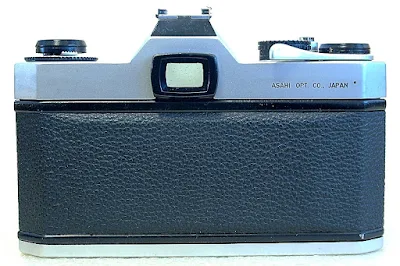The launch of the SPF was also accompanied by the release of the SMC Takumar series lenses, updating the previous Super-Mult-Coated Takumar line.
The new SMC Takumar lenses came fitted with added aperture-position linkages on the lens mount for the open-aperture metering system.
The feature, however, is not functional when older series Super-Multi-Coated Takumar lenses are mounted on the SPF. When using these lenses, you still have to meter stop down. This backward compatibility is provided for by the SPF through the metering system switch, as found on other Spotmatic camera models.
To cater to the extended capability of the camera, the battery for the SPF was upgraded to the now-defunct PX625 mercury cell, and the meter circuit design was revised to take account of the lens aperture setting and to indicate correct exposure when zero current is flowing through the meter, which now allowed for a variation in voltage from the battery.
Pentax Spotmatic F Video Manual 1 of 2
Pentax's Spotmatic F, along with the ESII, represented the end of the Spotmatic line. The Spotmatics left production on a high note with the F being the best...
On the SPF, the light meter is constantly switched on, but there is an automatic cut-off when the light is at EV2 or less, so it is important to keep the lens cap on when the camera is not in use to conserve the battery.
Basic Camera Features
Mechanically, the Pentax Spotmatic F is fitted with a focal plane shutter with a speed range from 1 to 1/1000 second, and B. Film ISO speed setting ranges from 20 to 3200 (LV3 -18 for ASA 100 film with 50mm lens), a built-in self-timer with 6-12 seconds delay, and shutter button lock. Metering is by a TTL CdS meter, which measures the average brightness of the ground glass, coupled directly to the shutter and film speed settings.
The Pentax Spotmatic F camera's body weight is 642 grams without batteries.
A simple front, with the lens housing mount bevel rising to form part of the pentaprism housing, with the self-timer lever located to the lower left and the FP and X-flash terminals located vertically to the right.
An equally plain back, with only the viewfinder eyepiece occupying the back of the pentaprism top, and the rest of the lower back occupied by the hinged film back.
The top plane, where all the functional controls of the camera are, is populated by the integrated pull-up and turn film rewind crank, film back pull-up latch control, and film type reminder dial located towards the left end of the camera top, with the pentaprism housing fitted and hot-shoe almost central of the top plane.
The film reminder dial can be manually set to indicate the use of 24 or 36-exposure film rolls, and film type - color daylight type, color tungsten type, or black and white.
On the right of the top plane, the integrated shutter speed and pull-up and turn film ISO setting dial, shutter button, lock, and the film forward crank are embedded with a small film counter window.
A red dot appears in a small window just aside from the shutter release button when the film is fully cranked and the shutter is cocked, which changes to black when the shutter is released.
On the bottom plane, the rewind release button, tripod socket, and film battery chamber cover.
The film box is a straightforward, quick-load system with the film canister chamber, the picture frame window, the sprocket gear, and a double-slit take-up spool. The film is loaded by pulling the tab end of the film roll across the back and slotted into the take-up spool before the film is wound firmly to ensure the sprocket tooth is properly engaged before the film back is closed.
Once the back is closed, use the two-blank shots technique to properly forward the start of the unexposed film roll to Frame 1.
Film Rewinding and Unloading
Film rewinding and unloading are done by a sequence of first pressing the film rewind release button located on the bottom plate of the camera, next by extending the crank tab of the film rewind crank out and turning it clockwise to spool the exposed film back into the film canister.
Open the film back and remove the film canister once the rewind process is complete, once the tension that you feel while rewinding the film is released.
Viewfinder Readout
The viewfinder of the Spotmatic F is a 93% field of view eye-level pentaprism finder fitted with non-interchangeable ground glass and microprism spot Fresnel screen.
The TTL metering mechanism display is a vertical +/- center-the-needle pointer scale located on the right of the viewfinder screen.
To set the camera for correct exposure, adjust the exposure needle indicator towards the middle of the opening. Setting the needle slightly above the center lightens the image in backlighted shots, and doing it in the opposite direction will lighten up darkened objects.
This is the technique normally used as a means of exposure compensation when using the Spotmatic F.
Battery
The Spotmatic F required the use of a PX-625 mercury cell when it was first introduced. Since the battery is not available anymore, substitutes in the form of a standard LR or SR 44 button cell have been used with no ill effects.




















No comments:
Post a Comment